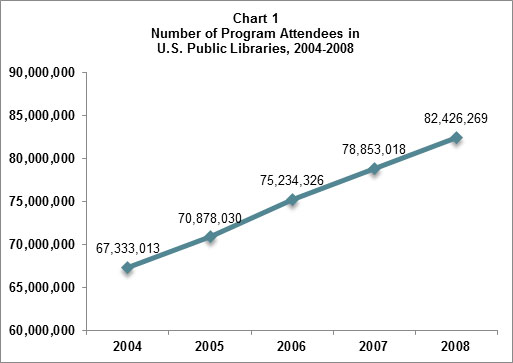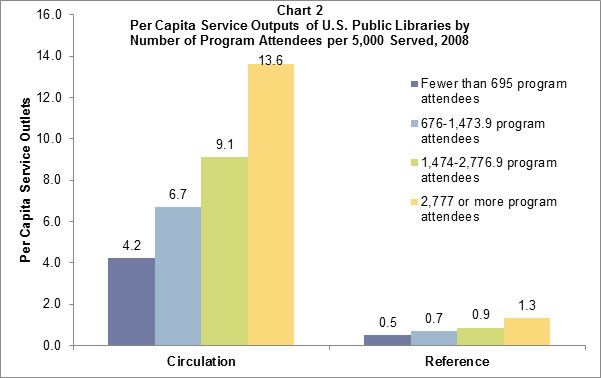Public libraries provide a wide range of programs for their communities, engaging, educating, and entertaining library patrons with everything from computer training to language classes to gaming. This important service has grown in recent years, with public libraries in the U.S. increasing the number of programs they offer by 33 percent between 2004 and 2008,[note]The most recent year for which national data is available.[/note] according to national data. Expanding program offerings has paid off, as program attendance has also substantially increased. During the same 4-year period, annual program attendance in U.S. public libraries increased by 22 percent (see Chart 1).
Colorado Public Libraries
- Between 2004 and 2008, Colorado mirrored the national increase in the number of programs offered at 33 percent
- Colorado’s program attendance has increased even more than the national totals, with a 33 percent increase between 2004 and 2008

How Program Attendance Relates to Use of Other Library Services
It is certainly good news that program attendance has increased, but some may wonder how much other library services are being used. The answer is that other library services are being used regularly. In fact, as the number of program attendees increased, circulation and reference questions also increased based on 2008 data (see Chart 2). For example, libraries in the top quartile (i.e., in the top 25% of public libraries in terms of program attendance per 5,000 served) circulate more than 3 times as many items as libraries with fewer than 695 program attendees (bottom quartile, or the bottom 25% in terms of program attendees per 5,000 served). This does not mean that one service causes the others to increase, but there is a positive relationship between these services. Libraries that have higher program attendance have higher circulation and more reference questions.
Note: Each bar represents a quartile of U.S. public libraries with program attendance per 5,000 people served.
There are significant, positive correlations between the number of program attendees and both service outputs discussed. In other words, as library programming attendance increases, other services increase, and these relationships are meaningful. Circulation has a strong relationship with program attendance, with a correlation of 0.41.[note]Statistically significant at the p < .01 level.[/note] The correlation between program attendance and reference is lower, at 0.20, but this is still a significant relationship.
Conclusion
More programs are being offered than ever in public libraries across the U.S. Attendance for these programs is steadily increasing and where program attendance is highest, use of other library services also increases. There are several possible reasons for the positive correlations between program attendance and use of other library services. Perhaps library programs are sparking an interest in attendees, causing them to seek out materials in the collection on the same topics or ask reference librarians for more information. Or, reference librarians may be promoting programs if their topics relate to the patrons’ reference questions. Regardless of the cause, it is important to note that libraries with higher program attendance also have higher circulation and more reference questions.
